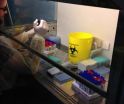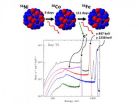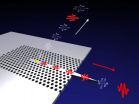(Press-News.org) FK506 possesses a well-studied neuroregenerative effect, stimulating neurite extension in the presence of nerve growth factor in vitro, and enhancing nerve regeneration following nerve crush injury and isografting. However, the use of FK506 to stimulate nerve regeneration is limited because of the risk of renal failure and hypertension, and its considerable cost. With long-term allografts, FK506 alone or combined with other drugs reportedly cause life-threatening infections. Like FK506, rapamycin is an immunosuppressant and FKBP-12-binding ligand, and has a neuroregenerative effect in vitro. Rapamycin has lower nephrotoxicity, lower risk of hypertension, and less neoplastic potential than FK506. Dr. Yixia Yin and co-workers from Wuhan University of Technology in China found that the lowest rapamycin concentration (1.53 nmol/L) more significantly promoted Schwann cell migration than the highest FK506 concentration (100 μmol/L). Rapamycin promoted the secretion of nerve growth factors and upregulated growth-associated protein 43 expression in Schwann cells, but did not significantly affect Schwann cell proliferation. Therefore, rapamycin has potential application in peripheral nerve regeneration therapy. These findings have been published in the Neural Regeneration Research.
INFORMATION:
Article: " Rapamycin promotes Schwann cell migration and nerve growth factor secretion," by Fang Liu1, Haiwei Zhang1, Kaiming Zhang1, Xinyu Wang2, Shipu Li2, Yixia Yin2 (1 Department of Orthopedics, Second Hospital of Yueyang, Yueyang, Hunan Province, China; 2 State Key Laboratory of Advanced Technology for Materials Synthesis and Processing, and Biomedical Materials and Engineering Center, Wuhan University of Technology, Wuhan, Hunan Province, China)
Liu F, Zhang HW, Zhang KM, Wang XY, Li SP, Yin YX. Rapamycin promotes Schwann cell migration and nerve growth factor secretion. Neural Regen Res. 2014;9(6):602-609.
Contact: Meng Zhao
eic@nrren.org
86-138-049-98773
Neural Regeneration Research
http://www.nrronline.org/
Rapamycin or FK506, which is better for SCs migration and peripheral nerve repair
2014-08-29
ELSE PRESS RELEASES FROM THIS DATE:
MERS: Low transmissibility, dangerous illness
2014-08-29
The MERS coronavirus has caused disease outbreaks across the Arabian Peninsula and spread to Europe several times. The severe pneumonia virus has claimed the lives of several hundred people since its discovery in 2012. For a long time, scientists have been puzzled over how easily the pathogen spreads from human to human. An international team of researchers led by virologists from the University of Bonn have now come to the conclusion, through direct observation, that the rate of human transmission is low. Still, a third of infected persons with symptoms die. The results ...
Astrophysicists report radioactive cobalt in supernova explosion
2014-08-29
A group of astrophysicists, including researchers from MIPT, have detected the formation of radioactive cobalt during a supernova explosion, lending credence to a corresponding theory of supernova explosions. Details are given in the journal Nature, one of the most cited scientific publications in the world.
The article's main author, Yevgeny Churazov (Space Research Institute of the Russian Academy of Sciences), together with his co-authors, including Sergei Sazonov of the Space Research Institute and MIPT, reported the results of their analysis of data collected with ...
Cellphone addiction 'an increasingly realistic possibility,' Baylor study finds
2014-08-29
Women college students spend an average of 10 hours a day on their cellphones and men college students spend nearly eight, with excessive use posing potential risks for academic performance, according to a Baylor University study on cellphone activity published in the Journal of Behavioral Addictions.
"That's astounding," said researcher James Roberts, Ph.D., The Ben H. Williams Professor of Marketing in Baylor's Hankamer School of Business. "As cellphone functions increase, addictions to this seemingly indispensable piece of technology become an increasingly realistic ...
'K-to-M' histone mutations: How repressing the repressors may drive tissue-specific cancers
2014-08-29
Kansas City, MO. - In a cell's nucleus, chromosomal DNA is tightly bound to structural proteins known as histones, an amalgam biologists call chromatin. Until about two decades ago, histones were regarded as a nuclear "sidekick," the mere packing material around which the glamorous DNA strands were wrapped. Recently, however, biologists have developed a greater appreciation for how DNA/histone interactions govern gene expression.
In 2012, investigators from multiple research institutions studying the sequence of the genome from cancer patients rocked the "chromatin world" ...
Copper shines as flexible conductor
2014-08-29
Bend them, stretch them, twist them, fold them: modern materials that are light, flexible and highly conductive have extraordinary technological potential, whether as artificial skin or electronic paper.
Making such concepts affordable enough for general use remains a challenge but a new way of working with copper nanowires and a PVA "nano glue" could be a game-changer.
Previous success in the field of ultra-lightweight "aerogel monoliths" has largely relied on the use of precious gold and silver nanowires.
By turning instead to copper, both abundant and cheap, ...
Meaningful relationships can help you thrive
2014-08-29
In brief:
The definition of thriving involves 5 components of well-being
Relationships provide 2 types of support: source of strength (SOS) support, and relational catalyst (RC) support
Support-providers must be sensitive and responsive—there are characteristics in a support-provider that can lead to doing more harm than good
Future research should focus more on social support in non-adverse life circumstances
Deep and meaningful relationships play a vital role in overall well-being. Past research has shown that individuals with supportive and rewarding relationships ...
Plug n' play protein crystals
2014-08-29
Almost a hundred years ago in 1929 Linus Pauling presented the famous Pauling's Rules to describe the principles governing the structure of complex ionic crystals. These rules essentially describe how the arrangement of atoms in a crystal is critically dependent on the size of the atoms, their charge and type of bonding. According to scientists from the Biohybrid Materials Group of Aalto University Finland led by Mauri Kostiainen similar rules can be applied to prepare ionic colloidal crystals consisting of oppositely charged proteins and virus particles. The results can ...
Managing coasts under threat from climate change and sea-level rise
2014-08-29
Coastal regions under threat from climate change and sea-level rise need to tackle the more immediate threats of human-led and other non-climatic changes, according to a team of international scientists.
The team of 27 scientists from five continents, led by Dr Sally Brown at the University of Southampton, reviewed 24 years of Intergovernmental Panel on Climate Change (IPCC) assessments (the fifth and latest set being published in 2013 and 2014). They focused on climate change and sea-level rise impacts in the coastal zone, and examined ways of how to better manage and ...
Mobile app on emergency cardiac care aids best decisions in seconds
2014-08-29
Barcelona, Spain –Saturday 30 August 2014: The ACCA Clinical Decision-Making Toolkit mobile app is now available on the App Store and Google Play.
When dealing with acute cardiovascular diseases, a few seconds can make the difference and instant access to the best recommendations can save lives. This led the Acute Cardiovascular Care Association (ACCA) of the ESC to develop a user friendly interactive application, allowing professionals to have immediate access to diagnostics pathways on their mobile devices.
The Toolkit on emergency cardiac care, first published as ...
Breakthrough in light sources for new quantum technology
2014-08-29
Electronic circuits are based on electrons, but one of the most promising technologies for future quantum circuits are photonic circuits, i.e. circuits based on light (photons) instead of electrons. First, it is necessary to be able to create a stream of single photons and control their direction. Researchers around the world have made all sorts of attempts to achieve this control, but now scientists at the Niels Bohr Institute have succeeded in creating a steady stream of photons emitted one at a time and in a particular direction. The breakthrough has been published in ...






